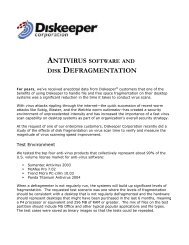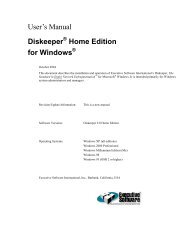Diskeeper 10 User's Manual
Diskeeper 10 User's Manual
Diskeeper 10 User's Manual
Create successful ePaper yourself
Turn your PDF publications into a flip-book with our unique Google optimized e-Paper software.
66 Answers to Frequently Asked Questions<br />
maintain optimum system performance, while on a workstation, you may only need to run <strong>Diskeeper</strong> once<br />
a day or less. As a general rule, the busier the disk—the more often it will need to be defragmented.<br />
• To determine how often to run <strong>Diskeeper</strong> on your disk volumes, you can use the logging function of<br />
<strong>Diskeeper</strong> to monitor the number of files moved during each <strong>Diskeeper</strong> run. For information about how<br />
files that are moved by <strong>Diskeeper</strong> are logged, see page 50. In general, if <strong>Diskeeper</strong> moves fewer than 50<br />
files per run, you are running <strong>Diskeeper</strong> frequently enough to maintain the performance of your Windows<br />
system at an optimum level. If the number of files moved during each run is greater, or is increasing,<br />
schedule <strong>Diskeeper</strong> to run more frequently. (Here again, you can automate this by letting the <strong>Diskeeper</strong><br />
Smart Scheduling feature control when to run <strong>Diskeeper</strong>.)<br />
How do I set access permissions to allow <strong>Diskeeper</strong> to defragment my files?<br />
In order for <strong>Diskeeper</strong> to have access to move files on NTFS volumes, both SYSTEM and ADMINISTRATOR<br />
must have full control over a file (or the directory folder it is in). This version of <strong>Diskeeper</strong> includes a batch file<br />
that sets the access permissions on a disk volume to allow <strong>Diskeeper</strong> to run properly. This batch file is called<br />
setdkacls.bat, and it is located in the directory folder where <strong>Diskeeper</strong> is installed.<br />
If you find you have made files inaccessible to <strong>Diskeeper</strong>, or that you have some files inaccessible to<br />
<strong>Diskeeper</strong>, open a command-prompt window, change directory to the <strong>Diskeeper</strong> installation directory, and type:<br />
setdkacls x:<br />
where x: is the letter name of the disk volume on which you want to change access permissions.<br />
The setdkacls.bat procedure automates the following sequence of commands:<br />
cd /d x:<br />
cd \<br />
cacls * /e /t /c /g Administrators:F System:F<br />
For more information about the cacls command, type cacls /? at a command prompt.<br />
This batch procedure will only work if the account you are logged onto has been granted access to the file(s)<br />
you are wanting to defragment.<br />
Why don’t my defragmentation jobs all start at the same time?<br />
Most editions of <strong>Diskeeper</strong> allow you to defragment more than one disk volume at a time. However, when the<br />
defragmentation of two or more disks is scheduled to begin at the same time, <strong>Diskeeper</strong> will start each job<br />
separately, in one-minute intervals. For this reason, you will notice the start times for each <strong>Diskeeper</strong> job run in<br />
the Application Event Log can vary by several minutes. This is no cause for alarm.<br />
Why doesn’t the free space reported by the post-analysis (or postdefragmentation)<br />
summary pop-up screen match what the <strong>Diskeeper</strong><br />
Fragmentation pane shows?<br />
Several post-analysis and post-defragmentation summary screens include information about the amount of free<br />
space available on the volume for defragmentation. This figure is based on the space available to <strong>Diskeeper</strong>,<br />
which may be less than the total free space on an NTFS volume. NTFS volumes reserve a percentage of the<br />
total volume for the Master File Table (MFT), which <strong>Diskeeper</strong> cannot use for defragmenting files. Because of<br />
this, the figure shown in the <strong>Diskeeper</strong> post-analysis and post-defragmentation summaries on NTFS volumes<br />
will not match the total free space figure displayed in the <strong>Diskeeper</strong> Fragmentation pane (or other utilities like<br />
Disk Properties in Windows Explorer).<br />
Should I use <strong>Diskeeper</strong> on RAID arrays?<br />
Yes—<strong>Diskeeper</strong> supports all levels of software- and hardware-based RAID arrays. RAID arrays are often used<br />
to increase system performance. In a RAID array of four disk drives, for example, a file can be accessed up to<br />
four times as fast as on a single drive. This is because the file is spread between the four drives, and all four<br />
drives can be accessed at the same time, so the file can be retrieved much faster. However, like the files on a<br />
single disk drive, these file parts can become fragmented on the individual drives, which reduces the speed






